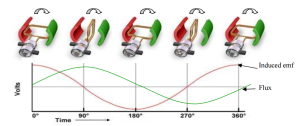Why D.C. Motor?
- Wide selection is available.
- It is easy to control using computer with relays or electronic switches.
- Open source electronics platforms such as Arduino can be used to operate it with the help of a motor driver.
- With a gearbox, larger DC motors can power heavy and complex robots.
Basic Principle
If a current carrying conductor is lying perpendicular to a magnetic field, then the interaction of current flowing through the conductor and the magnetic field present will produce mechanical force upon the conductor (and therefore, mechanical energy). Its value is given by:
F= B*i*L Newton
where B is the density of the magnetic field, l is the length of conductor, and i the value of current flowing in the conductor. The direction of motion can be found using Fleming’s Left Hand Rule.
When a current carrying coil is placed in a magnetic field, the force acts on it according to Fleming’s left hand rule, as a result, it starts rotating. In an actual DC motor, several such coils are wound on the rotor, all of which experience force, resulting in rotation. The greater the current in the wire, or the greater the magnetic field, the faster the wire moves because of the greater force created.

HOW TO SELECT A DC MOTOR?
In order to select motor for a robot or a machine, several key questions must be asked
1. How fast the motor is?
Ans: If the end effector part of the machine/ robot is directly attached to the motor, then the desired speed is the required speed. Moreover, by using gears or pulleys or any other power transmission device, the speed can be manipulated.
Any DC Motor can be characterized by the speed-torque graph.
2. How to know about the power required in the motor?
Ans: The total force required to move or actuate the machine or robot can be calculated using force equilibrium equations. This force, when multiplied by the desired angular or spin velocity and arm length, gives the power required. The maximum power required can be calculated at the half of its no-load current and half of its stall torque.
3. At what voltage will the motor operate?
Ans: The power required is also a product of current required and operating voltage. 3V, 6V, 12V and 24V are some of the common preferred voltages for DC motors. If a voltage lower than the voltage listen in the data sheet is applied to a motor, the torque will not overcome the internal friction – mostly from the brushes. Also, if a voltage higher than what the motor can support is applied, it may heat up and get damaged.
4. Can a motor work all the time?
Ans: It is related to the duty cycle of the motor. For low duty cycle, a brushed DC Motor can be used whereas for heavy duty cycles, brushless DC Motors are used.
MOTOR SPECIFICATIONS
There are two types of characteristics which are used to specify the type of motor
• Electric characteristics: These are nominal voltage, stall current and rated current. Most of the DC Motors work within a range of 12-24V and stall currents from 1-2A to 30A.
• Mechanical characteristics: These are stall torque, rated torque, no load speed of the motor etc. Most of the DC motor work between 5000rpm to 25000rpm.
This is a characteristic graph of a small DC Motor. Let the stall torque be known. So at that point, the current, output power and efficiency of the motor can be found out and these values can be used as the motor specifications. When speed is zero, then the other values are called ‘stall’ values. Mostly it is the highest value. Similarly ‘rated’ value means the maximum value a motor can access safely.
For e.g.: if the stall torque is given to be 15kg-cm, then, it is the torque at its no speed whereas if the rated torque is 15kg-cm, then, it is the maximum torque which can be applied on the motor safely.
Generally the motors should be operated at an approximate range of 75-95% of its no-load speed and 15-30% of its stall torque. The speed and torque will also depend on the external factors and weight of the robot/ machine. Thus for purchasing or choosing a motor, one can go for either an online calculator such as RMF Calculator or Electric Motor Calculator or search for similar specifications, according to the calculated values of electrical and mechanical characteristics.
Why D.C. Motor?
- Wide selection is available.
- It is easy to control using computer with relays or electronic switches.
- Open source electronics platforms such as Arduino can be used to operate it with the help of a motor driver.
- With a gearbox, larger DC motors can power heavy and complex robots.
Basic Principle
If a current carrying conductor is lying perpendicular to a magnetic field, then the interaction of current flowing through the conductor and the magnetic field present will produce mechanical force upon the conductor (and therefore, mechanical energy). Its value is given by:
F= B*i*L Newton
where B is the density of the magnetic field, l is the length of conductor, and i the value of current flowing in the conductor. The direction of motion can be found using Fleming’s Left Hand Rule.
When a current carrying coil is placed in a magnetic field, the force acts on it according to Fleming’s left hand rule, as a result, it starts rotating. In an actual DC motor, several such coils are wound on the rotor, all of which experience force, resulting in rotation. The greater the current in the wire, or the greater the magnetic field, the faster the wire moves because of the greater force created.

HOW TO SELECT A DC MOTOR?
In order to select motor for a robot or a machine, several key questions must be asked
1. How fast the motor is?
Ans: If the end effector part of the machine/ robot is directly attached to the motor, then the desired speed is the required speed. Moreover, by using gears or pulleys or any other power transmission device, the speed can be manipulated.
Any DC Motor can be characterized by the speed-torque graph.
2. How to know about the power required in the motor?
Ans: The total force required to move or actuate the machine or robot can be calculated using force equilibrium equations. This force, when multiplied by the desired angular or spin velocity and arm length, gives the power required. The maximum power required can be calculated at the half of its no-load current and half of its stall torque.
3. At what voltage will the motor operate?
Ans: The power required is also a product of current required and operating voltage. 3V, 6V, 12V and 24V are some of the common preferred voltages for DC motors. If a voltage lower than the voltage listen in the data sheet is applied to a motor, the torque will not overcome the internal friction – mostly from the brushes. Also, if a voltage higher than what the motor can support is applied, it may heat up and get damaged.
4. Can a motor work all the time?
Ans: It is related to the duty cycle of the motor. For low duty cycle, a brushed DC Motor can be used whereas for heavy duty cycles, brushless DC Motors are used.
MOTOR SPECIFICATIONS
There are two types of characteristics which are used to specify the type of motor
• Electric characteristics: These are nominal voltage, stall current and rated current. Most of the DC Motors work within a range of 12-24V and stall currents from 1-2A to 30A.
• Mechanical characteristics: These are stall torque, rated torque, no load speed of the motor etc. Most of the DC motor work between 5000rpm to 25000rpm.
This is a characteristic graph of a small DC Motor. Let the stall torque be known. So at that point, the current, output power and efficiency of the motor can be found out and these values can be used as the motor specifications. When speed is zero, then the other values are called ‘stall’ values. Mostly it is the highest value. Similarly ‘rated’ value means the maximum value a motor can access safely.
For e.g.: if the stall torque is given to be 15kg-cm, then, it is the torque at its no speed whereas if the rated torque is 15kg-cm, then, it is the maximum torque which can be applied on the motor safely.
Generally the motors should be operated at an approximate range of 75-95% of its no-load speed and 15-30% of its stall torque. The speed and torque will also depend on the external factors and weight of the robot/ machine. Thus for purchasing or choosing a motor, one can go for either an online calculator such as RMF Calculator or Electric Motor Calculator or search for similar specifications, according to the calculated values of electrical and mechanical characteristics.
